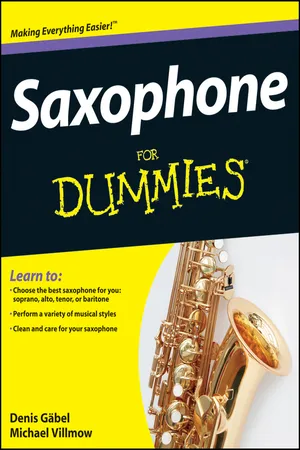Part I
Basic Information about the Saxophone
In this part . . .
So you’re about to have your first rendezvous with the saxophone. This part gets you ready to sound those first notes.
Chapter 1 introduces you to the genius Adolphe Sax. You find out about the origin of the saxophone and meet the entire sax family. You also get advice and tips to help you find the right saxophone for you. Chapter 2 explains how to put together a saxophone and everything else you need to start playing, including how to tune your sax. Chapter 3 describes the best posture for playing a saxophone and proper breathing technique. We also tell you how to position your mouth to make a beautiful saxophone sound.
Chapter 1
Saxophone Basics
In This Chapter
Saying hello to Adolphe Sax
Discovering the different parts of the saxophone
Meeting the saxophone family: soprano, alto, tenor, and baritone
Buying or leasing your first saxophone
So your dream is to learn how to play the saxophone — one of the coolest musical instruments around. Picking up this book is a great start, but now comes your first big decision: Which type of saxophone do you want to play? Saxophones come in different sizes, make different sounds, and have different names. How do you choose?
Don’t get overwhelmed by choice. For beginners, an alto or tenor saxophone is probably best, because these two are of medium size and widely available. After you’ve mastered the instrument (which you no doubt will), you’ll have plenty of time to explore the high notes of the soprano sax or the low tones of the baritone.
Besides helping you answer the question “Which saxophone suits me best?” this chapter also introduces you to its inventor, Adolphe Sax. It gives you tips on buying a saxophone so you can make an informed choice, and helps you decide whether to lease your first saxophone or buy a used one. And so you can get to know the sax a little better, this chapter also gives an overview of the saxophone’s parts and what they do.
Meeting Mr. Sax
If Adolphe Sax, the nineteenth century Belgian thinker and inventor, could visit today’s world, he would be amazed at the saxophone’s popularity. This imaginative and risk-taking inventor was obsessed with the idea of attempting a kind of musical genetic engineering. He created his namesake instrument — the saxophone — to unify the best features of the trumpet and the clarinet.
The invention of the saxophone
The saxophone was born in 1842. Adolphe Sax, the father of this new wind instrument, was a clarinet and flute player. The son of an instrument maker, crafting and tinkering with musical instruments ran in his family. But Adolphe was also an inventive and imaginative guy. During his lifetime, he invented many wind instruments such as the sax horn, the sax tuba, and the sax trombone — remarkable hybrids that unfortunately did not survive into our millennium. And that’s not all. Mr. Sax also invented a steam organ, medical instruments, and even a cannon called the “saxocannon”! But the saxophone was his greatest and most enduring invention.
Rumor has it that when Adolphe Sax invented the saxophone, he wanted to create a wind instrument as flexible and light as the clarinet, for playing melodic structures, but that could also stand up to the power and assertiveness of brass instruments such as the trumpet and trombone. He brought his saxophone prototype to the royal court in his home country of Belgium and gave a persuasive performance. He suggested to the royals that his instrument be used in military music, and they accepted.
The saxophone’s inclusion in military music opened the door to many opportunities for other people to play and hear the new horn. The saxophone quickly became very popular among musicians. However, the saxophone sound also had its foes. Some instrument manufacturers resisted the saxophone, and they threatened to go to court to put a stop to Mr. Sax manufacturing the instrument. Even today, a saxophone is rarely part of a symphony orchestra.
Unfortunately, Adolphe Sax’s final days were rather sad. He died in Paris in 1894, completely bankrupt.
The saxophone goes mainstream
When Henri Selmer took over manufacturing the saxophone, things really took off. Dance bands established the sax in the field of light music. In the 1930s, many radio stations played the song “Petite Fleur,” by soprano saxophonist Sidney Bechet, who became the first world-renowned player.
Then came the big bands, led by famous bandleaders such as Count Basie and Duke Ellington. They showed off their large sax sections with as many as five sax players, usually in the first row. Their sax sections set the air on fire!
Some of the early pioneers of the saxophone were Lester “Prez” Young, Charlie “Bird” Parker, and Coleman “Hawk” Hawkins. Jazz flourished, and even today the saxophone is a critical element of this style. The melody of one of the most famous jazz compositions, “Take Five,” was composed and played by Paul Desmond, with his lyrically magnificent alto sax sound.
Even rock ’n’ roll incorporated the saxophone. Can you imagine Bill Haley’s “Rock Around the Clock” or “See You Later, Alligator” without the sax parts?
Mr. Sax’s horn also bec...







